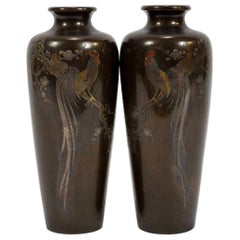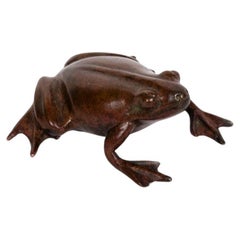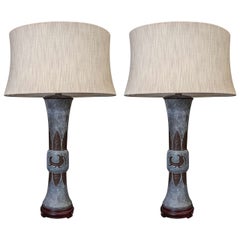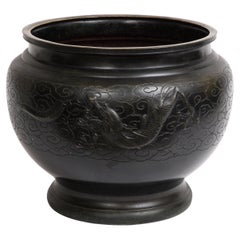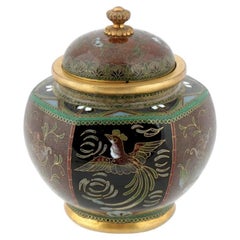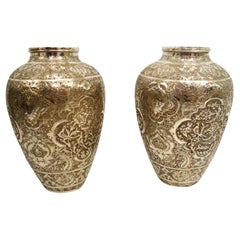Late 19th Century Metalwork
to
48
217
145
382
11
5
1
126
883
845
27
441
182
56
40
12
20
8
10
8
23
10
5
1
380
144
110
87
83
357
300
222
75
30
382
382
382
12
4
3
3
2
Period: Late 19th Century
Pair of Japanese Bronze Vase with Metal Inlays by Mitsufune
Located in Atlanta, GA
A pair of elegant vases of solid oiled bronze from the Meiji era, Japan (1868-1912). In a Classic Meiping shape, the pair has a mirrored inlay with gold, silver and red enamel that d...
Category
Japanese Japonisme Antique Late 19th Century Metalwork
Materials
Bronze
Japanese Tiny bronze frog
Located in PARIS, FR
Adorable tiny bronze frog in cast bronze with a splendid brownish patina, almost
orange, lying on its rear legs, ready to jump. The casting of this bronze was very well
conducted, ...
Category
Japanese Meiji Antique Late 19th Century Metalwork
Materials
Bronze
Pair 19th Century Chinese Lead Vases Inlayed with Bronze Lamps
Located in Hudson, NY
This pair of vases are from China. Made as part of a 19th century alter garniture set the pair are now lamps. Cast in lead which has been inlayed with bronze decorative elements incl...
Category
Chinese Archaistic Antique Late 19th Century Metalwork
Materials
Bronze, Lead
A Japanese Meiji Period Patinated Bronze Centerpiece/Bowl w/ Dragon in Relief
Located in New York, NY
A Fantastic and large Japanese Meiji Period Patinated Bronze Centerpiece/Bowl/jar denier with Dragon in Relief. This captivating and exquisite, hand-crafted, patinated bronze centerpiece serves as a remarkable focal point, adorned with marvelously hand-chassed and hand-chiseled dragons in relief, gracefully emerging and disappearing behind artfully stylized scrolling etched clouds. The centerpiece boasts a substantial and graceful curved base, complemented by a striking peaked and square-edged lip atop the vessel.
The significance behind the depiction of the three-clawed dragons stems from the Japanese belief that Eastern dragons originated within their native land. According to their folklore, as these majestic creatures ventured away from Japan, they acquired additional toes. The Japanese Sky dragon...
Category
Japanese Meiji Antique Late 19th Century Metalwork
Materials
Bronze
Antique Early Meiji Japanese Cloisonne Enamel Bird Jar Attributed to Honda
Located in Long Island City, NY
An antique Japanese, early Meiji era, enamel over gilt copper covered jar. The exterior of the jar is adorned with polychrome enamel medallions representing Phoenix birds, and flower...
Category
Japanese Meiji Antique Late 19th Century Metalwork
Materials
Copper, Enamel
Pair of Antique Signed Islamic Ottoman or Persian Repousse Silver Vases
Located in Buenos Aires, Olivos
A fine Pair of Islamic silver vases.
Richly decorated with Ishafan (Eshafan) style repousse decoration throughout including gryphon heads, flowers & vines, birds of paradise, foliage...
Category
Unknown Islamic Antique Late 19th Century Metalwork
Materials
Silver
Large Meiji Period Cloisonne Enamel Koro
Located in London, GB
Large Meiji Period Cloisonne Enamel Koro
Japanese, late 19th Century
Height 88cm, width 76cm, depth 53cm
This superb cloisonne enamel koro was made during...
Category
Japanese Meiji Antique Late 19th Century Metalwork
Materials
Bronze, Enamel
Japanese bronze cover censer, 19th c .
Located in New York, NY
decorated with birds and flowers in relief; 4in(D) x 7.5in(W) x 12in(H) are the overall dimensions of the cover censer with the wooden base
Category
Chinese Antique Late 19th Century Metalwork
Materials
Bronze
A Very Fine Miniature Japanese Mixed Metal Bronze Bottle Vase, Meiji Period
Located in Ottawa, Ontario
The finely proportioned ovoid shaped body rising to an elongated slender neck with a flaring rim, decorated with motifs of waterfowl standing in a grassy marsh with silvered bodies, ...
Category
Japanese Meiji Antique Late 19th Century Metalwork
Materials
Gold, Silver, Bronze, Copper
A Japanese patinated bronze vase depicting a cricket
Located in Milano, IT
A slender shape patinated bronze vase depicting a naturalistic scene of a cricket sitting on iris leaves.
Signed Joun in relief within an oval reserve.
Origin: Japan
Period: Meiji ...
Category
Japanese Japonisme Antique Late 19th Century Metalwork
Materials
Bronze
$3,302 Sale Price
20% Off
Japanese Bronze Vessel with Dragon Handles and Falcon Lid
Located in Greenwich, CT
Japanese bronze vessel with pair of dragon handles, falcon lid, birds in landscape and elephant heads base.
Category
Japanese Meiji Antique Late 19th Century Metalwork
Materials
Bronze
Bronze sculpture of two cicadas on a bamboo, used by calligraphs to hold paper
Located in PARIS, FR
Two cicadas in bronze facing each other on a bamboo segment
One is an adult while the other is at the nymph phase. Three foundry stamps, one underneath and one alongside each insect...
Category
Japanese Meiji Antique Late 19th Century Metalwork
Materials
Bronze
Antique Meiji Japanese Cloisonne Enamel Pink And Purple Plate With Children
Located in Long Island City, NY
An antique Japanese plate adorned with a polychrome cloisonne enamel design. The central scene features several children. The background is a v...
Category
Japanese Antique Late 19th Century Metalwork
Materials
Enamel
A Fine Japanese Cloisonne Enamel Vase and Cover. Meiji Period
Located in London, GB
A Exquisite Cloisonne Enamel Vase and cover
Meiji period -Late 19th C
Exquisite and refined four sided cloisonne vase and cover made in gold and silver wire with dragons and phoen...
Category
Japanese Antique Late 19th Century Metalwork
Materials
Enamel
Japanese bronze sculpture of a ginseng root, ganodermas mushrooms growing on it
Located in PARIS, FR
Bronze sculpture representing a group of genoderma mushrooms developing on the long stem of a Ginseng root that is standing on two kakis. Logically this root would be Panax ginseng, ...
Category
Japanese Meiji Antique Late 19th Century Metalwork
Materials
Bronze
Chinese Export Silver Mug
By Leeching
Located in London, GB
A Chinese export silver mug with flowers and foliage engraved within decorative panels; and a dragon handle. Marked with LC, for Leeching, 利升 (...
Category
Chinese Chinese Export Antique Late 19th Century Metalwork
Materials
Silver
Rare Meiji Japanese Cloisonne Red Enamel Green and White Dragon Jar
Located in Long Island City, NY
A rare antique Japanese late Meiji Era tripod and covered enamel copper censer koro. Circa: late 19th century to early 20th century. The sphere form censer koro is enameled with poly...
Category
Japanese Meiji Antique Late 19th Century Metalwork
Materials
Enamel, Copper
Group of Three Brass Vases Lotas Tanjore South India
Located in Ottawa, Ontario
Group of three brass vases
Probably, Tanjore, South India
19th century
The bodies of flattened, spherical form,
rising to the narrowed neck and a ...
Category
Indian Anglo-Indian Antique Late 19th Century Metalwork
Materials
Brass
Pair of Japanese urns. 19th c. Meiji period. Signed.
Located in Stockholm, SE
These pair of Japanese bronze urns from the Meiji period have decorations of birds and flowers. The inlays are made of silver, gilt bronze and shakudo. Both urns are signed at the bo...
Category
Japanese Antique Late 19th Century Metalwork
Materials
Bronze
Japanese Three Drawer Copper Lined Hibachi. Circa 1870
Located in Charleston, SC
KYOTO STYLE NAGA HIBACHI (FIREBOX BRAZIER GRILL), Japanese, Meiji Period, The rectangular hibachi is of Keyaki (Zelkova) wood construction with the original copper liner, and a colum...
Category
Japanese Antique Late 19th Century Metalwork
Meiji Period Signed Bronze and Mixed Metal Bonsai Planter or Brush Pot
Located in Ottawa, Ontario
Meiji period (1868-1912) signed bronze and mixed metal bonsai planter or brush pot, polygon shaped (six sided) decorated with different scenes on each p...
Category
Japanese Meiji Antique Late 19th Century Metalwork
Materials
Metal, Bronze
Meiji Period Bronze of a Boy Carrying Twigs
Located in Lymington, Hampshire
A Meiji period bronze of a boy carrying twigs, they are strapped onto his back on a carrying frame and he carries a gourd water bottle in his right hand, signed in a seal. Japanese, ...
Category
Japanese Meiji Antique Late 19th Century Metalwork
Materials
Bronze
Japanese Bronze sculpture of a standing Mouse holding an Hazelnut
Located in PARIS, FR
It is a very convincing bronze sculpture of a mouse with a light brown patina, represented with an astonishing set of detail on its eyes, nose and fur. She is seated on her rear paws...
Category
Japanese Meiji Antique Late 19th Century Metalwork
Materials
Bronze
Meiji Period Japanese Bronze Vase with Grasses and Quail Design
Located in Hudson, NY
Meiji Japanese bronze vase with grasses and Quail design, Meiji period (1868-1912) bronze vase with elaborate raised design of wild grasses,...
Category
Japanese Meiji Antique Late 19th Century Metalwork
Materials
Bronze
Collection of Ten Chinese Ceremonial Poles
Located in London, by appointment only
A fine set of ten polished brass ceremonial spears each with different and unusually elaborate symbolic spear heads representing good fortune, power and strength, long life, accomplishment. One of the few conventional spears is a rare Chinese spear with the double crescent moons either side of a elongated spear head. A Guan Dao...
Category
Chinese Qing Antique Late 19th Century Metalwork
$38,155 Sale Price / set
20% Off
A bronze vase depicting an Onagadori rooster on a plum branch
Located in Milano, IT
A bronze vase with mixed metal inlay applications, including silver, gilt bronze, and patinated bronze, featuring at its center an onagadori rooster perched on a blossoming plum (ume...
Category
Japanese Antique Late 19th Century Metalwork
Materials
Metal, Silver, Bronze
Japanese Bronze sculpture of a Mouse holding a korn knob
Located in PARIS, FR
An interesting bronze sculpture of a seated mouse holding a small corn knob. Realistic treatment of the fur, eyes, hears nose and mouth, its tail is curving on the left side of the s...
Category
Japanese Meiji Antique Late 19th Century Metalwork
Materials
Bronze
Opium Wieght in the Form of a Buddhist lion
Located in PARIS, FR
Tiny opium weight in bonze with brownish patina in the shape of a Buddhist guardian lion, also name Fo dog, characteristic with its exorbitated eyes and an embossed and wavy mane and...
Category
Cambodian Folk Art Antique Late 19th Century Metalwork
Materials
Bronze
Antique Edo Japanese Cloisonne Geometric Design Box
Located in Long Island City, NY
An antique Japanese brass enamel ceremonial food container with a cover adorned with a pointed finial. Characterized by cloisonne floral designs...
Category
Japanese Meiji Antique Late 19th Century Metalwork
Materials
Brass, Enamel
Antique Chinese Qing Dynasty 1644-1911 Enamel on Copper Cloisonne Plate Bowl
Located in Portland, OR
A fine antique Chinese Qing Dynasty (1644-1911) cloisonne shallow bowl, circa 1880.
The bowl is finely decorated with gold spiral cloisons on a black enamel ground, to the center is ...
Category
Chinese Qing Antique Late 19th Century Metalwork
Materials
Copper, Enamel
Genryusai Seiya Japanese Meiji Man & Water Buffalo Sculpture on Stand
Located in Bishop's Stortford, Hertfordshire
An exceptional Japanese Meiji bronze sculpture of a man and water buffalo on a natural polished oak stand by renowned Japanese master craftsman Genryusai Seiya and dating from around 1880/90. The large bronze depicts an elderly man holding a pipe and tobacco pouch...
Category
Japanese Anglo-Japanese Antique Late 19th Century Metalwork
Materials
Bronze
$18,368 Sale Price
20% Off
Japanese Silver Enamel Incese Burner (Koro) Meiji Period
By Sanju Saku
Located in Sarasota, FL
Japanese silver and enamel Incense Burner (Koro) Meiji era (1868-1912), late 19th century. The koro is set on tripod feet, The body decorated with three panels of birds and flowers w...
Category
Japanese Antique Late 19th Century Metalwork
Materials
Silver
Antique Japanese Bronze Vase with Landscape and Red Patina
Located in Hudson, NY
Antique Japanese bronze vase with landscape and red patina, Meiji Period (1868-1912) bronze vase with wild grasses under a silver moon. Re...
Category
Japanese Meiji Antique Late 19th Century Metalwork
Materials
Silver, Bronze
Antique Asian Hindu Bronze Temple Toy Camel on Wheels
By Rajhastani
Located in North Hollywood, CA
Inspired by a scene from Ramakian or Ramayan, the Indian epic Rama and Sita.
Antique Indian Temple Toy bronze camel on wheels.
Antique hindu bronze temple camel with rider statue toy on wheels.
Commonly known as "Temple Toys...
Category
Indian Folk Art Antique Late 19th Century Metalwork
Materials
Bronze
Antique Japanese Meiji Era Cloisonne Enamel Plate Goto
Located in Long Island City, NY
An antique Japanese, probably Goto school, enamel over copper charger plate.
The exterior of the plate is adorned with a polychrome image of ducks flying over a pond with blossomin...
Category
Japanese Antique Late 19th Century Metalwork
Materials
Copper, Enamel
Antique 19th Century Brass Islamic Middle Eastern Floor Lamp
Located in North Hollywood, CA
Extremely fine antique Islamic floor brass lamp with Kufic Mamluke revival pierced foliate openwork’s chased and chiselled with arabic calligraphy and figures.
Antique 19th century Middle Eastern Egyptian floor decorative candle lamp,
Rising from wide trumpet foot through to slightly tapering cylindrical shaft with two pronounced collars to gently flaring mouth and flat rim, the shaft with pierced openwork lattice containing scrolling vine issuing from cusped palmettes, bordered above and below by bands of engraved scrolling floral vine, the upper section of the foot and the body below the mouth with further pierced openwork sections in rectangular cusped cartouches with similar design set in a ground of engraved scrolling floral vine, interlocking palmettes and stylized cloud bands, band of verses.
This large floor Moorish Syrian Middle Eastern...
Category
Egyptian Moorish Antique Late 19th Century Metalwork
Materials
Brass
A pair of bronze vases with Onagadori roosters
Located in Milano, IT
Pair of bronze vases adorned with inlays, decorated with two Onagadori roosters, known for their elegant length of tail. The roosters are represented perched on a plum branch.
Signe...
Category
Japanese Japonisme Antique Late 19th Century Metalwork
Materials
Bronze
$2,217 Sale Price
20% Off
Japanese Meiji Bronze Takaoka Vase with Waterfowl and Moon Design
Located in Hudson, NY
Japanese Meiji bronze Takaoka vase with waterfowl and moon design
Meiji period (1868-1912) bronze vase from Takaoka, in Toyama prefecture, is a city historically known for its metal work. Vase has silver inlay moon and waterfowl, signature on the bottom: Yoshihiko, full name of artist...
Category
Japanese Meiji Antique Late 19th Century Metalwork
Materials
Silver, Bronze
Chinese Export Silver Bowl
By Luen Wo
Located in London, GB
Chinese Export Silver Bowl, profusely decorated with chrysanthemum, prunus, iris, and bamboo, and with a vacant circular cartouche. The bowl d...
Category
Chinese Chinese Export Antique Late 19th Century Metalwork
Materials
Silver
Japanese Bronze Group of Mice, Pumpkin and Pomegranate
Located in PARIS, FR
Polychrome bronze of a group of mice around a pumpkin and a pomegranate. The five mice have a dark brown patina, while the hollowed-out gourd is dark brown and the split pomegranate ...
Category
Japanese Antique Late 19th Century Metalwork
Materials
Bronze
Large Antique Japanese Cloisonne Enamel on Porcelain Totai Jar Signed
Located in Long Island City, NY
A large antique Japanese late Meiji era covered Totai enamel on porcelain ginger jar. Circa: late 19th century to early 20th century. The ware is enameled with a polychrome fan shaped medallions with blossoming flowers, and butterflies, surrounded by floral and butterfly wings patterns made in the Cloisonne technique. The cover of the ware is decorated with a polychrome image of a flower surrounded by floral, foliage, and butterfly wings made in the same technique. The neck, the base, and the lid are adorned with polychrome geometrical, and floral motifs made in the same technique. Signed with red ink hieroglyphs, on the bottom. Totai Shippo is the name given to Japanese cloisonne on ceramics, both on earthenwares and on porcelain. It has a similar appearance to metallic cloisonne ware...
Category
Japanese Meiji Antique Late 19th Century Metalwork
Materials
Enamel
Antique Tibetan Silver Ceremonial Ewer
Located in Montreal, QC
This is a water ewer used in Tibetan ritual offerings to the "hungry ghosts". They have been reborn so, as a result of greed and avarice and are condemned to wander as spirits with b...
Category
Tibetan Tibetan Antique Late 19th Century Metalwork
Materials
Silver
Japanese Bronze Pair of Geese Koros
Located in Downingtown, PA
Japanese bronze geese koros,
Late 19th century.
The pair of goose koros or censors are in the form of geese with their long necks extended and their ...
Category
Japanese Japonisme Antique Late 19th Century Metalwork
Materials
Metal
A lobed cloisonné enamel dish depicting a Ryu dragon
Located in Milano, IT
A Japanese cloisonné enamel dish with a lobed rim, decorated with the figure of a Ryu dragon rendered in shaded enamels in shades of green, light blue, pink, and yellow, outlined by ...
Category
Japanese Antique Late 19th Century Metalwork
Materials
Enamel
19th Century Oriental Bronze Japanese Kagami Handled Mirror
Located in North Hollywood, CA
Antique traditional Oriental bronze Japanese Kagami handled Mirror.
An exceptional and stunning Japanese bronze handled mirror called Kagami.
Large and heavy bronze handle mirror ...
Category
Japanese Meiji Antique Late 19th Century Metalwork
Materials
Bronze
Cloisonné vase depicting an eagle watching chidori in flight
Located in Milano, IT
Vase decorated with polychrome cloisonné enamels on a midnight blue ground, worked in silver wire depicting an eagle perched on a rock observing chidori fleeing over turbulent waters...
Category
Japanese Antique Late 19th Century Metalwork
Materials
Enamel
$9,528 Sale Price
20% Off
Rare Antique Meiji Japanese Cloisonne Charger Plate
Located in Long Island City, NY
A rare antique Japanese Meiji era, enamel over copper charger plate. The exterior of the plate is adorned with a polychrome scene with an eagle and nestlings on black ground made in ...
Category
Japanese Meiji Antique Late 19th Century Metalwork
Materials
Enamel, Copper
Antique Japanese Meiji Era Cloisonne Enamel Plate
Located in Long Island City, NY
An antique Japanese Meiji era enamel over copper charger plate. The exterior of the plate is adorned with a polychrome scene with an eagle standing on a rock and cranes flying over w...
Category
Japanese Meiji Antique Late 19th Century Metalwork
Materials
Copper, Enamel
$1,250 Sale Price
50% Off
Antique Japanese Cloisonne Enamel Butterfly and Insect Plate Charger
Located in Long Island City, NY
An antique Japanese late Meiji era decorative enamel over copper plate or charger. The interior of the plate is adorned with a polychrome design of butterflies surrounded by sakura f...
Category
Japanese Meiji Antique Late 19th Century Metalwork
Materials
Copper, Enamel
Chinese Late Qing Pair Cloisonne Floral Pattern Vases
Located in Bishop's Stortford, Hertfordshire
An exceptional and stunning pair antique Chinese Qing cloisonné enamel vases decorated with floral patterning dating from the late 19th or early 20th century. The bulbous bottle shap...
Category
Chinese Qing Antique Late 19th Century Metalwork
Materials
Brass, Enamel
Chinese Export Silver Card Case
Located in London, GB
Chinese Export Silver Case embossed and chased with a dragon playing with a fireball on one side, and decorated on the other side with a poem — “亲向罗浮伴月痕,至怜花尽冷霜根” (Qin Xiang Luo Fu Ba...
Category
Chinese Chinese Export Antique Late 19th Century Metalwork
Materials
Silver
19th Century Turkish Bath Clog With Mother of Pearl Inlay
Located in Stamford, CT
19th century Turkish bath clog, or Nalin, walnut with mother of pearl and silver wire inlay. Ottoman Empire, worn to the public bath houses or Hamma...
Category
Turkish Other Antique Late 19th Century Metalwork
Materials
Lead
Japanese Wireless Cloisonné Serving Tray Meiji After Namikawa Sosuke
Located in Long Island City, NY
A rare 19th Century Japanese copper serving tray with cloisonne enamel design. The central part of the tray depicts a wireless cloisonne picture, a coastal landscape view with a full moon. The hieroglyphical signature of the artist is in the lower right. The rims and the backside are decorated with floral ornaments. Blue and black color palette. Collectible Oriental Decor And Applied Arts For Interior Design.
Namikawa Sosuke (1847–1910) was a Japanese cloisonné artist,[1] known for innovations that developed cloisonné enamel into an artistic medium sharing many features with paintings.[2][3] He and Namikawa Yasuyuki (no relation)[notes 1] were the most famous cloisonné artists of the 1890 to 1910 period, known as the "golden age" of Japanese enamels.[1] Around 1880 he set up and ran the Tokyo branch of the Nagoya Cloisonné Company.[1] He exhibited his artworks at national and international expositions, where he took an organising role.[2] He was recognised as an Imperial Household Artist and created art works for imperial residences. He sometimes signed his works with the character sakigake (Pioneer)
the art work is based off a art work done by Sesshu Toyo
Sesshu Toyo (?? ??, c. 1420 – August 26, 1506), also known simply as Sesshu (??), was a Japanese Zen monk and painter who is considered a great master of Japanese ink painting. Initially inspired by Chinese landscapes, Sesshu's work holds a distinctively Japanese style that reflects Zen Buddhist aesthetics.[1] His prominent work captured images of landscapes, portraits, and birds and flowers paintings, infused with Zen Buddhist beliefs, flattened perspective, and emphatic lines.[2]
Sesshu was born into the samurai Oda family (???) and trained at Shokoku-ji temple in Kyoto, Japan, as a Zen monk.[1] From his early childhood, Sesshu showed a talent for painting and eventually became widely revered throughout Japan as a wise, reputable Zen scholar, and the greatest painter priest of Zen-Shu.[3]
Sesshu worked in a painting atelier whilst training under Tensho Shubun (c. 1418–1463). But upon visiting China, his work betook a distinctive Chinese influence, merging Japanese and Chinese styles to develop his individualistic style of Zen paintings.[3] Sesshu's influence on painting was so wide that many schools of art appointed him their founder.[4] Sesshu's most acclaimed works are Winter Landscape (c. 1470s), Birds and Flowers (1420–1506) and Four Landscape Scrolls...
Category
Japanese Antique Late 19th Century Metalwork
Materials
Copper, Enamel
Arabian Middle Eastern Dallah Moorish Coffee Pot
Located in North Hollywood, CA
19th century Middle Eastern traditional Arabian tinned copper and brass Dallah coffee pot.
Moorish Coffee pot hand-hammered copper with riveted brass fi...
Category
Omani Islamic Antique Late 19th Century Metalwork
Materials
Brass, Copper
Antique Japanese Cloisonne Flying Geese Enamel Plate Goto
Located in Long Island City, NY
An antique Japanese late Meiji era decorative enamel over copper plate or charger. Attributed to Goto
The interior of the plate is adorned with a polychrome design of flying geese ...
Category
Japanese Meiji Antique Late 19th Century Metalwork
Materials
Enamel, Copper
$2,250 Sale Price
50% Off
Antique Mughal Engraved 19th Century Hookah Base Indo-Persian
Located in North Hollywood, CA
A fine antique 19th century Mughal Nargile or hookah pipe base made of brass or bronze, the base with engraving and etching decorations.
Mameluke revival brass hookah base, elaborately and elegantly hand decorated, engraved with with a recessed repeated floral motif, leaf, foliage and arabesques.
Collectible Antique Indian Islamic Mughal engraved brass hookah base, bottle.
This fascinating Indo-Persian Brass Engraved Vessel Hookah Base dates from the 19th century, where it was used as a water base for a hookah, or shisha pipe.
In traditional hookah smoking, the base of the pipe is normally the most decorative element of the piece.
This vase has a beautiful shape and feel. It is intricately engraved with a arabesque foliage designs
Mughal Northern India - 19th century.
A nargile or hookah pipe's history dates back as far back as the 16th century,
This charming piece has an elegant profile, will make a stunning vase, candle holder or shelf or mantel decoration...
Category
Indian Islamic Antique Late 19th Century Metalwork
Materials
Brass
Antique Chinese Qing Dynasty Archaic Style Bronze Enamel Champlevé Censer 1900
Located in Portland, OR
Antique Chinese archaic style bronze enamel Champlevé Censer / Incense Burner, circa 1900.
The lidded censer having a male Foo dog finial, below the ...
Category
Chinese Qing Antique Late 19th Century Metalwork
Materials
Bronze, Enamel
$1,060 Sale Price
20% Off
Antique Meiji Large Japanese Cloisonne Enamel Geometric Pattern Plate Charger
Located in Long Island City, NY
An antique Japanese Meiji era decorative enamel over copper plate. The plate is made in a swirl panel design. The panels are adorned with polychrome images of blossoming flowers, and...
Category
Japanese Meiji Antique Late 19th Century Metalwork
Materials
Copper, Enamel
Antique Meiji Japanese Cloisonne Enamel Geometric Brush Pot Vase
Located in Long Island City, NY
An antique Japanese late Meiji Era cylindrical shaped enamel brush pot. Circa: late 19th century. The cylindrical form pot is enameled with polychrome medallions depicting a scene wi...
Category
Japanese Meiji Antique Late 19th Century Metalwork
Materials
Enamel
$1,000 Sale Price
50% Off
Antique Meiji Japanese Cloisonne Enamel Hikite Door Handle
Located in Long Island City, NY
An antique Japanese gilt copper Fusuma Hikite sliding door handle with polychrome cloisonne enamel design. Late Meiji period, before 1912. The door...
Category
Japanese Meiji Antique Late 19th Century Metalwork
Materials
Copper, Enamel
